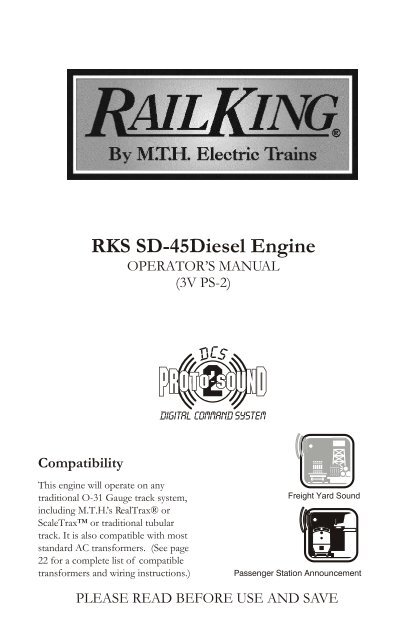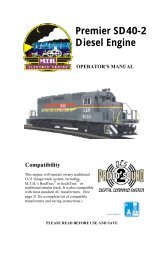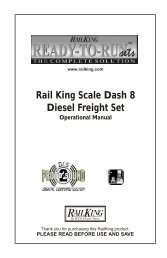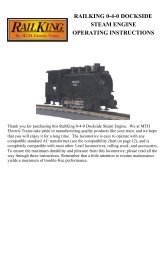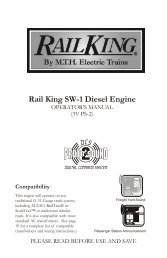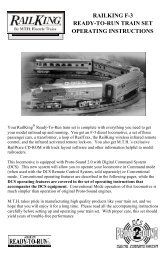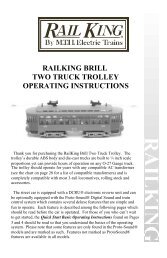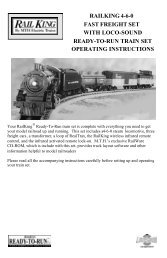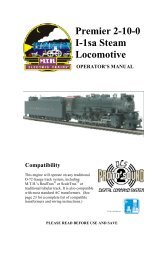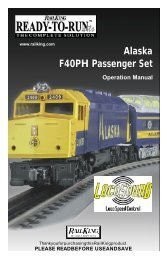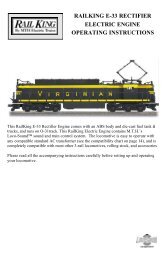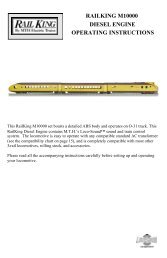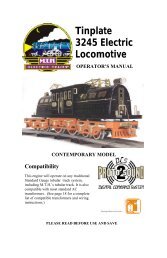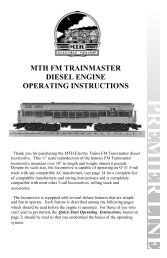RKS SD-45 Diesel.cdr - MTH Trains
RKS SD-45 Diesel.cdr - MTH Trains
RKS SD-45 Diesel.cdr - MTH Trains
Create successful ePaper yourself
Turn your PDF publications into a flip-book with our unique Google optimized e-Paper software.
Table of ContentsSet Up Checklist...........................................................................................................Lubrication.......................................................................................................Checking the Battery.......................................................................................Priming the Smoke Unit.................................................................................Basic Operation.............................................................................................................Activating Features...........................................................................................Manual Volume Control..................................................................................333<strong>45</strong>56Proto-Sound 2.0 Operating Instructions................................................................ 7Activating Proto-Sound 2.0 Conventional Mode Features........................ 7Freight Yard Sounds (FYS)/Passenger Station Announcements (PSA).. 7Proto-Coupler® Operation............................................................................ 8Speed Control................................................................................................... 9Locking Locomotive Into A Direction......................................................... 9Reset To Factory Default................................................................................. 10Automatic Sound Effects................................................................................. 10Maintenance....................................................................................................................Lubricating and Greasing Instructions.........................................................Cleaning The Wheels, Tires and Track.........................................................Traction Tire Replacement Instructions.......................................................Locomotive Light Bulb Replacement.............................................................Self Charging Battery Back-Up......................................................................ProtoSmoke Unit Operation...........................................................................Troubleshooting Proto-Sound® 2.0 Problems............................................Additional Features Accessible with the DCS Remote Control System..Transformer Compatibility and Wiring Chart............................................Service & Warranty Information...................................................................Limited One-Year Warranty.............................................................................111112131415161821222323CAUTION: ELECTRICALLY OPERATED PRODUCT:Not recommended for children under 10 years of age. M.T.H. recommends adult supervision with children ages 10 - 16.As with all electric products, precautions should be observed during handling and use to reduce the risk of electric shock.WARNING: When using electrical products, basic safety precautions should be observed, including the following:Read this manual thoroughly before using this device.● M.T.H. recommends that all users and persons supervising use examine the hobby transformer and other electronic equipmentperiodically for conditions that may result in the risk of fire, electric shock, or injury to persons, such as damage to the primarycord, plug blades, housing, output jacks or other parts. In the event such conditions exist, the train set should not be used untilproperly repaired.● Do not operate your layout unattended. Obstructed accessories or stalled trains may overheat, resulting in damage to your layout.● This train set is intended for indoor use. Do not use if water is present. Serious injury or fatality may result.● Do not operate the hobby transformer with damaged cord, plug, switches, buttons or case.This product may be protected by one or more of the following patents:6,019,289; 6,280,278; 6,281,606; 6,291,263; 6,<strong>45</strong>7,681; 6,491,263; 6,604,641;6,619,594; 6,624,537; 6,655,640.©2006, M.T.H. Electric <strong>Trains</strong>, Columbia, MD 21046
Set Up Checklist- Lubricate the locomotive- Check to see whether the battery needs to be charged for full sound effects- Prime the smoke unit- Apply power to run as described in the Basic Operating Section of this manualLubricationYou should lubricate the engine to prevent it from squeaking. Uselight household oil and follow the lubrication points marked “L” inFig. 1. Do not over-oil. Use only a drop or two on each pivot point.DO NOTOVER OILLubricate Pick Up Roller Axles (L)Figure 1. Lubrication Points on the LocomotiveLubricate All Wheel Axles (L)Checking the BatteryYou may find, if your locomotive was built several months before you set it up,that the rechargeable battery has run down and needs to be charged beforeoperating. If you notice that the sounds are garbled, test and charge the engine asdescribed in the "Self-Charging Battery Back-Up" on page 16.<strong>RKS</strong> <strong>SD</strong>-<strong>45</strong> <strong>Diesel</strong> Engine with PS-23
Priming the Smoke UnitWhen preparing to run this engine, add 15-20 drops of smoke fluid through thesmokestack (see Figure 2). We recommend M.T.H. ProtoSmoke, Seuthe, LGB, orLVTS fluids. Do not overfill the unit or the fluid may leak out and coat the interiorengine components.If you choose not to add smoke fluid (or have already added fluid but choose torun smoke-free), turn off the smoke unit by turning the smoke unit control fullyCounter Clockwise. Failure either to add fluid to the smoke unit or to turn itoff may damage the smoke unit heating element and/or wicking material.Add Smoke FluidFigure 2. Adding Smoke FluidRunning the engine without a primedsmoke unit may cause damageSmoke Unit ON/OFF ControlFigure 3. Smoke Unit Control<strong>RKS</strong> <strong>SD</strong>-<strong>45</strong> <strong>Diesel</strong> Engine with PS-24
Basic OperationThe Throttle knob controls how fast your train will travel. Turn the throttle knobup ½-way, until the engine and caboose lights shine bright. Put the engine intomotion by pressing the Direction button on your transformer once. (hold it forapproximately 1 second)If the engine does not begin to move as soon as you firmly press the Directionbutton, you may not have sent enough voltage to the track to make the train move.Turn the throttle up a bit higher until the train begins to move.Activating FeaturesThrottle - To increase or decrease track voltage, and therefore train speed, turn thethrottle control knob. Turning clockwise will increase voltage and speed, whileturning counterclockwise will decrease voltage and speed. The engine will maintainthe speed you set after you release the throttle until you turn it again to change thevoltage and speed.Bell - To sound the bell, in an engine equipped with a bell firmly press and releasethe Bell button. To turn the bell off, press and release the Bell button again. Thebell will continue to ring from the time you turn it on until you press and releasethe button again to turn it off.Horn/Whistle - To sound the whistle, firmly press the Horn/Whistle button. Thewhistle will sound for as long as you continue to depress the button. It will stopwhen you release the button.Direction - Your train is programmed to start in neutral. The train will alwayscycle neutral-forward-neutral-reverse with each press and release of the directionbutton. The engine is programmed to restart in neutral each time the track voltageis turned off for 25 seconds or more.Cycle PhasesReverseNeutralNeutralForward<strong>RKS</strong> <strong>SD</strong>-<strong>45</strong> <strong>Diesel</strong> Engine with PS-25
Manual Volume ControlTo adjust the volume of all sounds made by this engine, turn the master volumecontrol knob located next to the fuel tank clockwise to increase the volume andcounter-clockwise to decrease the volume.Volume Adjustment KnobFigure 4. Manual Volume Adjustment Knob<strong>RKS</strong> <strong>SD</strong>-<strong>45</strong> <strong>Diesel</strong> Engine with PS-26
Proto-Sound 2.0 Operating InstructionsThismanual contains the operating instructions for Proto-Sound 2.0 in conventionalmode only. Instructions for accessing DCS command mode features accompanythe DCS Remote Control System equipment.Activating Proto-Sound 2.0 Conventional Mode FeaturesProto-Sound 2.0 features are activated by sequences of Bell and Horn buttonpushes described below. Please read the full descriptions of each feature beforeusing it. To use these buttons to activate features rather than to blow the horn orring the bell, you should tap the buttons very quickly with a ½-second pausebetween button presses. You may need to practice your timing to make this worksmoothly.PressHornShort &Firm½ Sec.PauseFeature to Be Activated:Freight Yard SoundsFire the Rear CouplerFire the Front CouplerSpeed Control On/OffLock into a Direction/UnlockReset to Factory DefaultsTiming ChartPressBellShort &FirmTotal Time Lapse: 1 ½ Seconds½ Sec.PausePressBellShort &FirmButton Code:1 Bell, 2 Whistle/Horn1 Bell, 3 Whistle/Horn1 Bell, 4 Whistle/Horn1 Whistle/Horn, 2 Bells (From Neutral Only)1 Whistle/Horn, 3 Bells1 Whistle/Horn, 5 Bells (From Neutral Only)Freight Yard Sounds (FYS) orPassenger Station Announcements (PSA):Your engine is equipped with a sound package of either freight yard or passenger stationsounds that you can play. Each sequence described below will play as long as it is lefton, randomly generating sounds, but be sure to allow approximately 30 secondsbetween the button pushes described below to allow the FYS/PSA sufficient time torun through each sequence. To cue the sound system to play the FYS/PSA, quickly but firmly tap the Bell buttononce followed by 2 quick taps of the Horn/Whistle button while the engine is moving.Tap the buttons quickly but allow approximately ½ second between each press.Press the Direction button once to stop the engine. This will trigger the first sequenceof FYS/PSA. The reverse unit is temporarily disabled so that the train will not move asyou use the Direction button to trigger the sounds, and Proto-Sound 2.0 has disabledoperator control over the Horn/Whistle and Bell buttons until the full FYS/PSAsequence is complete.After waiting about 30 seconds for that sequence to run, press the Direction buttonagain to trigger the second sequence of FYS/PSA.After about 30 seconds, press the Direction button again to trigger the third FYS/PSAsequence.Again, after allowing about 30 seconds for that sequence to run, press the Direction<strong>RKS</strong> <strong>SD</strong>-<strong>45</strong> <strong>Diesel</strong> Engine with PS-27
Reset to Factory Defaults:To override the settings you currently have assigned to the engine and reset it to its factorydefaults, while in Neutral tap the Horn/Whistle button quickly once, followed by five quicktaps of the Bell button, allowing approximately ½ second to lapse between each quickbutton press. Two horn/whistle blasts will indicate that the engine has made the change.PlaceEngine inNeutralHorn/Whistle=ResetTwo Whistle Blasts(indicates change is made)Repeat to Returnto Normal ConditionAutomatic Sounds:Certain Proto-Sound 2.0 sound effects automatically play in programmed conventionalmode conditions: Squealing Brakes play any time the engine's speed decreases rapidly.Cab Chatter plays at random intervals when the engine idles in neutral.Engine Start-up and Shut-down sounds play when the engine is initially powered onor is powered off for five seconds or more.<strong>RKS</strong> <strong>SD</strong>-<strong>45</strong> <strong>Diesel</strong> Engine with PS-210
MaintenanceLubricating and Greasing InstructionsThe engine should be well oiled and greased in order to run properly.Regularly lubricate all axles and pickup rollers to prevent squeaking.Use light household oil, such as that found in M.T.H.'s maintenancekit. Do not over oil. Use only a drop or two on each pivot point.DO NOTOVER OILBody Mount ScrewsMotor Mount ScrewsBody Mount ScrewsMotor Mount ScrewsFigure 5. Body Removal Screw LocationsGrease Idler Gear (G)The locomotive’s internal gearing was greased at the factory and should not needadditional grease until after 50 hours of operation or one year, whichever comesfirst. Follow the greasing instructions below. Note that in some tightly packedengines you may need to move internal components temporarily in order to accessthe gears.1. To access the gear box, remove the cab from the chassis by unscrewing the bodymount screws as seen in Figure 5 and lifting the cab from the chassis.2. Once the cab is removed, remove the trucks by unscrewing the black Phillipsmotor mount screw located on the underside of the drive trucks (see Figure 5).3. Once the motor mount screw has been removed, pull the motor away from thetruck block and lightly coat the motor worm gear and bronze drive gear (in thetruck block) with grease.4. Reassemble the truck and motor, being careful not to pinch any wires betweenthe truck block and motor mount.<strong>RKS</strong> <strong>SD</strong>-<strong>45</strong> <strong>Diesel</strong> Engine with PS-211
5. After repeating the procedure for the other motor, reassemble the chassis andbody, being careful that the wire harnesses are not caught between the chassis andbody, and reinstall the body mount screws.Lubricate the outside truck block idler and drive gears with grease. Use thediagram shown in Figure 6 below as a guide and add grease to the points marked.Figure 6. Greasing The Idler GearsGrease Idler Gear (G)Cleaning The Wheels, Tires, and TrackPeriodically check the locomotive wheels and pickups for dirt and buildup, whichcan cause poor electrical contact and traction and prematurely wear out theneoprene traction tires. Wheels and tires can be cleaned using denatured (notrubbing) alcohol applied with a cotton swab.To clean the track, use RailKing Track Cleaning Fluid or denatured (not rubbing)alcohol and a clean rag. Unplug the transformer and wipe the rails of the track,turning the rag frequently to ensure that you are using clean cloth on the rails.Thereafter, keep an eye on the track and clean it when it gets dirty to ensure goodelectrical contact and to lengthen the life of the tires.<strong>RKS</strong> <strong>SD</strong>-<strong>45</strong> <strong>Diesel</strong> Engine with PS-212
Traction Tire Replacement InstructionsYour locomotive is equipped with two neoprene rubber traction tires on eachpowered truck block. While these tires are extremely durable, you may need toreplace them at some point.First, remove the truck sides from the truck block. To do this, turn your engineupside down. If there are visible Phillips screw heads between the truck frameand truck block (see Fig. 7), go to step A. If not, go to step B.A. Remove the two Phillips screws that attach each truck side to the truck block.B. Remove the trucks (see page 11) from the chassis and the truck sides fromthe trucks in order to slip the new tire over the grooved drive wheel. Once thetruck sides have been removed:1. Make sure the old tire has been completely removed from the groove in thedrive wheel, using a razor blade or small flathead screwdriver to pry away anyremains.2. Slip the new tire onto thewheel. You may find it usefulto use two small flatheadscrewdrivers to stretch the tireover the wheel.3. If you twist the tire whilestretching it over the wheel,you will need to remove andreinstall the tire. Otherwiseyour engine will wobble whileoperating.4. Make sure the tire is fully seatedinside the groove. Use a razor bladeto trim away any excess tire thatdoesn’t seat itself inside the groove properly.5. Reassemble in reverse order.Truckside ScrewsFigure 7. Truckside Screws(Reference Picture Only-Actual Model May Look Different)One set of replacement tires is packaged with the model. Additional tires areavailable directly from the M.T.H. Parts Department (phone: 410-381-2580; fax:410-423-0009; e-mail: parts@mth-railking.com; mail: 7020 Columbia GatewayDrive, Columbia MD 21046-1532).<strong>RKS</strong> <strong>SD</strong>-<strong>45</strong> <strong>Diesel</strong> Engine with PS-213
Locomotive Light Bulb ReplacementTo replace the burned out light bulbs on this locomotive, follow these instructions.Follow the cab removal instructions in the “Lubrication and GreasingInstructions” section on pg.11 of this manual. Once the body has been removed,locate burned out light bulb(s). Carefully remove bulb(s) from mounting.Disconnect light bulb harness from main harness wire.Replacement bulb harnesses are available directly from the M.T.H. Partsdepartment.Connect replacement bulb harness and reassemble in reverse..<strong>RKS</strong> <strong>SD</strong>-<strong>45</strong> <strong>Diesel</strong> Engine with PS-214
Self Charging Battery Back-upThe special NiCad 2.4v self-charging battery recharges continuously during trainoperation and should last for up to five years. The battery is a dry battery thatshould not leak or cause any damage to your engine. Depending upon when yourengine was built, it may need to be charged right out of the box. If engine soundsseem distorted or garbled at low voltages or become silent when power from thetransformer is turned off, test the battery to determine whether it should berecharged or replaced.Test: Put the engine in neutral and leavethe track voltage at 10-12 volts (highenough for the lights to shine brightly) for15 minutes.Recharge: If the sounds are improved atthe end of the 15-minute test charge, thebattery charge has run down and can berecharged. There are a number of waysyou can do this:Battery Charger PortLeave the engine in neutral with track voltage at 10-12 volts for 6-7 hours sothe battery can fully recharge (if your engine has a smoke unit, be sure it isturned off).Use M.T.H.'s battery recharger (sold separately) that plugs into a wall outletand a special port under the engine to recharge the battery overnight withoutleaving it on the track.Replace: If the sounds are not improved at the end of the 15-minute test charge,it is time to replace the battery. Available through M.T.H. Parts. A standard 9valkaline battery can be substituted until your replacement arrives, but since alkalinebatteries cannot be recharged, it will eventually wear down. Do NOT use a 6-cell7.2v battery.Lift Out Battery<strong>RKS</strong> <strong>SD</strong>-<strong>45</strong> <strong>Diesel</strong> Engine with PS-215
ProtoSmoke® Unit OperationThis diesel locomotive contains a Proto-Sound 2.0 controlled smoke unit thatoutputs smoke through the smokestack on the roof of the engine. The smoke unitis essentially a small heating element and wick that soaks up and then heats amineral oil-based fluid that emits smoke. The smoke is then forced out of thestack by a small electric fan. Smoke volume is controlled by the Proto-Sound 2.0system.With a few easy maintenance steps, you should enjoy trouble-free smoke unitoperation for years.When preparing to run this engine, add 15-20 drops of smoke fluid through thesmokestack (see Figure 7). We recommend M.T.H. ProtoSmoke, Seuthe, LGB, orLVTS fluids. Do not overfill the unit or the fluid may leak out and coat the interiorengine components.Add Smoke FluidFigure 2. Adding Smoke FluidTo adjust the amount of smoke produced, turn the smoke unit volume controlclockwise to increase the amount of smoke, or counter-clockwise to reduce theamount (se Figure 3)If you choose not to add smoke fluid (or have already added fluid but choose torun smoke-free), turn off the smoke unit by turning the smoke unit control fullyCounter Clockwise (see Figure 3). Failure either to add fluid to the smoke unitor to turn it off may damage the smoke unit heating element and/orwicking material.When the smoke output while running the engine begins to diminish, add another10-15 drops of smoke fluid or turn the smoke unit off.When storing the unit for long periods of time, you may want to add about 15drops of fluid to prevent the wick from drying out.After removing the engine from storage, add another 25 drops of fluid, letting thewick soak up the fluid for 15 minutes prior to operation.<strong>RKS</strong> <strong>SD</strong>-<strong>45</strong> <strong>Diesel</strong> Engine with PS-216
After removing the engine from storage, add another 25 drops of fluid, letting thewick soak up the fluid for 15 minutes prior to operation.If you experience poor or no smoke output when the smoke unit is on and hasfluid, check the wick to see if it has become hard, blackened, and unabsorbentaround the heating element. After removing the locomotive body from its chassis(See Figure 5), remove the smoke unit inspection cover (see Figure 8). Afterremoving the inspection cover screws, lift the inspection plate away and inspect thewick. If it is darkly discolored and hard, it should be replaced.Replacement parts and wick replacement instructions are available directly fromthe M.T.H. Parts Department (order online: www.mth-railking.com, e-mail:parts@mth-railking.com; mail: 7020 Columbia Gateway Drive, Columbia MD21046-1532, FAX: 410-381-6122).Inspection CoverScrewsInspection CoverScrewsFigure 8. Inspecting the Smoke Unit Wick<strong>RKS</strong> <strong>SD</strong>-<strong>45</strong> <strong>Diesel</strong> Engine with PS-217
Troubleshooting Proto-Sound® ProblemsAlthough Proto-Sound 2.0 has been designed and engineered for ease of use,you may have some questions during initial operation. The following tableshould answer most questions. If your problem cannot be resolved with thistable, contact M.T.H. for assistance (telephone: 410-381-2580; fax: 410-423-0009;service@mth-railking.com, 7020 Columbia Gateway Drive, Columbia MD21046-1532).Starting UpWhen I first turn the power on, theengine will not begin to run. Ihave to turn the throttle off andthen on again to get the engine tooperate.Whistle/HornWhen I press the whistle/hornbutton, the bell comes on instead.I can’t get the horn to blow when Ipress the whistle button.BellWhen I press the whistle button,the bell sounds.I can’t get the bell to ring when Ipress the bell button.The bell won’t work on a separatebell button.CouplerWhen I try to fire the coupler, FYSstarts.The Proto-Coupler won’t let theengine uncouple on the fly.The coupler does not fire or staycoupled.RemedyThis is normal behavior. Toprevent accidental high-speedstart-ups, Proto-Sound 2.0 isprogrammed to start up in neutralanytime track power has beenturned off for several seconds.RemedyReverse the transformer leads.You may be pressing the buttontoo Remedy quickly. Try pressing thewhistle/horn button more slowly,taking approximately one fullsecond to fully depress the button.RemedyReverse the transformer leads.You may be pressing the buttontoo quickly. Try pressing the bellbutton more slowly, takingapproximately one full second tofully depress the button.Check the wiring of the separatebutton.RemedyYou are waiting too long betweenwhistle button presses.Try lubricating the coupler knucklewith a dry graphite lubricant. DoNOT use oil.The coupler needs to be cleaned.Wipe with denatured alcohol (notrubbing alcohol) and let dry.<strong>RKS</strong> <strong>SD</strong>-<strong>45</strong> <strong>Diesel</strong> Engine with PS-218
Cab ChatterSometimes the Cab Chattersounds don’t play.Lock-outI can’t get the engine to run after Ipower up the transformer. It sitsThe engine won’t lock intoforward, neutral, or reverse.RemedyCab Chatter plays only in neutralat random intervals.RemedyThe engine is locked into theneutral position. Follow theprocedure in the “Lock into aDirection” section.Engine speed must be below 10scale mph (approx. 10 volts orless in conventional mode).VolumeThe sounds seem distorted,especially when the whistle or bellis activated.BatteryThe engine will not leave the initialneutral setting.RemedyProto-Sound 2.0 volume is set toohigh. Turn the volume control knobon the bottom of the chassiscounter-clockwise to reduce thevolume.RemedyCheck to be sure the battery isinstalled and fully charged. Seethe “Self-Charging Battery Back-Up” section.I get no sounds when the engineshifts between directions.After I turn off my transformer, myengine continues to make soundsbefore quitting.The battery may be dead or needto be charged. See the “Self-Charging Battery Back-Up”section.Proto-Sound 2.0 is designed tocontinue to sound for a fewseconds after power to the trackhas been shut off.FYS/PSAThe FYS/PSA sounds occasionallyrepeat themselves.RemedyProto-Sound 2.0 has a built-inrandom number generator thatrandomly selects each sound clipto play. Because there are alimited number of sound clipsavailable in each FYS/PSAsequence, it is probable that someof these sound clips will berepeated from time to time.<strong>RKS</strong> <strong>SD</strong>-<strong>45</strong> <strong>Diesel</strong> Engine with PS-219
FYS/PSAOnce in FYS/PSA, the enginedoesn’t go into reverse.RemedySo that FYS/PSA effects can be asrealistic as possible, Proto-Sound2.0 disables the reversing unitwhenever FYS/PSA is enabled.This way the engine remains stillat its stop as the operator cyclesthrough the FYS/PSAsequences.When the FYS/PSA enters its lastsequence the bell automaticallycomes on.When FYS/PSA is enabled,pressing the whistle and bellbuttons has no effect.I push the direction button but thenext sound clip in the sequencedoes not play or the engine doesnot come out of FYS/PSA afterfourth press of the directionbutton.FYS/PSA is programmed to startringing the bell at that point. Afterapproximately 12 seconds it willautomatically turn off.Because FYS/PSA must controlvarious effects in each sequence,Proto-Sound 2.0 takes control ofthese sound effects until you exitEach FYS/PSA clip must play forapprox. 30 seconds beforeFYS/PSA will advance to the nextstep in the FYS/PSA cycle. Waitat least 30 seconds in eachFYS/PSA sound clip beforepressing the direction button.<strong>RKS</strong> <strong>SD</strong>-<strong>45</strong> <strong>Diesel</strong> Engine with PS-220
Additional Features Accessible With The DCSRemote Control System(Additional equipment required)While conventional mode operation of a Proto-Sound 2.0 engine yieldswonderfully realistic sound and several train control features, command modeoperation allows the user to access a world of command functions never beforeaccessible to O Gauge railroaders. With the addition of the DCS Remote ControlSystem (including a DCS remote handheld and Track Interface Unit) users gainmany advanced features, including:•DCS Proto-Speed Control - Establishes desired locomotive speed inscale miles per hour increments via a thumbwheel control and allowsoperator to set maximum speed and acceleration/deceleration rates•ProtoSmoke® Variable Output Control - Controls how much smokeeach engine outputs and matches smoke to locomotive speed•Locomotive Lighting Control - Controls locomotive headlights, markerand interior lights, beacon lights, ditch lights, and MARS lights•Emergency Stop-Single button push stops all Proto-Sound 2.0 trains butdoes not turn off the power•One Touch Global Mute/UnMute-Single button mutes or unmutes allDCS-controlled locomotives' user-defined actions, including sound, lights,and smoke•Proto-Dispatch Operation-Public Address-like feature allows users tospeak through locomotive speaker during operation•Proto-Cast-Allows users to play audio recordings through locomotivespeaker during operation•Proto-Doppler Sound Effects Set Up-Users can configure locomotivefor Doppler Operation, including setting distance points for Dopplerstart, repeat, and stop modes•Independent Volume Control of Engine Sounds, Bell, Horn & Whistlefor each Locomotive•Control up to 50 different DCS-Equipped Locomotives at one time withmultiple TIUs•Proto-Effects Set Up-User can select individual Proto-Effectsoperations to be active or inactive, including cab chatter, train wrecksounds, coupler sounds, Direction Control Set Up-User can set initialindividual start-up direction (start in forward or reverse) for doubleheadingoperations•Locomotive Consist Set-up-User can determine locomotive values forconsist make-ups, allowing multiple locomotives belonging to a consist tooperate together<strong>RKS</strong> <strong>SD</strong>-<strong>45</strong> <strong>Diesel</strong> Engine with PS-221
Transformer Compatibility and Wiring ChartProto-Sound 2.0 is designed to work with most standard AC transformers.The chart below lists the many compatible transformers. Note that many of theoperational commands described in these instructions require a bell button, so ifyour transformer does not have its own bell button, you should consider addingone to get the full benefit of the system. In addition, the chart details how theterminals on these transformers should be attached to your layout.RECOMMENDED AC TRANSFORMERSTransformerModelCenter RailOutside RailMin/Max.VoltagePowerRatingTransformerType<strong>MTH</strong> Z-500 Red Terminal Black Terminal 0-18v 50-Watt Electronic<strong>MTH</strong> Z-750Red TerminalBlack Terminal0-21v75-WattElectronic<strong>MTH</strong> Z-1000Red TerminalBlack Terminal0-21v100-WattElectronic<strong>MTH</strong> Z-4000 Red Terminal Black Terminal 0-22v 390-Watt ElectronicLionel 1032 U A 5-16v 90-Watt StandardLionel 1032M U A 5-16v 90-Watt StandardLionel 1033 U A 5-16v 90-Watt StandardLionel 1043 U A 5-16v 90-Watt StandardLionel 1043M U A 5-16v 90-Watt StandardLionel 1044 U A 5-16v 90-Watt StandardLionel 1053 U A 8-17v 60-Watt StandardLionel 1063UA8-17v60-WattStandardLionel LWAU8-18v75-WattStandardPowermasterUA8-18v135VAElectronicAll-Trol Left Terminal Right Terminal 0-24v 300-Watt ElectronicDallee Hostler Left Terminal Right Terminal ElectronicLionel LW A U 8-18v 75-Watt StandardLionel KW A or B U 6-20v 190-Watt StandardLionel MWOutside TrackTerminalInside TrackTerminal5-16v 50V.A. ElectronicLionel RS-1 Red Terminal Black Terminal 0-18v 50V.A. ElectronicLionel RW U A 9-19v 110-Watt StandardLionel SW U A Unknown 130-Watt StandardLionel TW U A 8-18v 175-Watt StandardLionel ZWA,B,C or DU8-20v275-WattStandardLionel Post-WarCelebrationSeries ZWA,B,C or DCommon0-20v135/190 WattElectronic* Conventional Mode Only<strong>RKS</strong> <strong>SD</strong>-<strong>45</strong> <strong>Diesel</strong> Engine with PS-222
Service & Warranty InformationHow to Get Service Under the Terms of the Limited One-Year WarrantyWhen you suspect an item is defective, please check the operator's manual for standard operation and troubleshootingtechniques that may correct the problem. Additional information may be found on the M.T.H. Website.Should you still require service, follow the instructions below to obtain warranty service.First, e-mail, write, call or fax a M.T.H. Authorized Service Center (ASC) in your area to obtain RepairAuthorization. You can find the list of ASCs on the M.T.H. Website, www.mth-railking.com. AuthorizedService Centers are required to make warranty repairs on items sold only from that store; all other repairs may--or may not be done at the store's own discretion. If you did not purchase the item directly from the ASC, youwill need to select a National Authorized Service Center (NASC). These centers are compensated by M.T.H. toperform warranty service for any customer whose repair qualifies for warranty ser vice. A list of NASC retailerscan be located on the M.T.H. Website or by calling 410-381-2580. Should the warranty no longer apply, you maychoose either an ASC or NASC retailer to service your M.T.H. Product. A reasonable service fee will becharged.CAUTION: Make sure the product is packed in its original factory packaging including its foam and plasticwrapping material to prevent damage to the merchandise. There is no need to return the entire set if only oneof the components is in need of repair unless otherwise instructed by the Service Center. The shipment must beprepaid and we recommend that it be insured. A cover letter including your name, address, daytimephone number, e-mail address (if available), Return Authorization number (if required by the servicecenter, a copy of your sales receipt and a full description of the problem must be included to facilitatethe repairs. Please include the description regardless of whether you discussed the problem with aservice technician when contacting the Service Center for your Return Authorization.Please make sure you have followed the instructions carefully before returning any merchandise for service.Authorized M.T.H. Service Centers are independently owned and operated and are not agents or representativesof M.T.H. Electric <strong>Trains</strong>. M.T.H. assumes no responsibility, financial or otherwise, for material left in theirpossession, or work done, by privately owned M.T.H. Authorized Service Centers.If you need assistance at any time email <strong>MTH</strong> Service at service@mth-railking.com, or call 410 381-2580.Limited One-Year WarrantyAll M.T.H. products purchased from an Authorized M.T.H. Train Merchant are covered by thiswarranty.See our website at www.mth-railking.com or call 410-381-2580 to identify an Authorized M.T.H. TrainMerchant near you.M.T.H. products are warrantied for one year from the date of purchase against defects in material orworkmanship, excluding wear items such as light bulbs, pick-up rollers, batteries, smoke unit wicks, and tractiontires. We will repair or replace (at our option) the defective part without charge for the parts or labor, if the itemis returned to an M.T.H. Authorized Service Center (ASC) or M.T.H. National Authorized Service Center(NASC) within one year of the original date of purchase. This warranty does not cover damages caused byimproper care, handling, or use. Transportation costs incurred by the customer are not covered under thiswarranty.Items sent for repair must be accompanied by a return authorization number, a description of the problem, anda copy of the original sales receipt from an Authorized M.T.H. Train Merchant, which gives the date ofpurchase. If you are sending this product to an Authorized Service Center, contact that Center for their retur nauthorization.This warranty gives you specific legal rights, and you may have other rights that vary from state to state. Specificquestions regarding the warranty may be forwarded to M.T.H. Directly.Service Department:M.T.H. Electric <strong>Trains</strong>7020 Columbia Gateway Drive.Columbia MD 21046-1532


